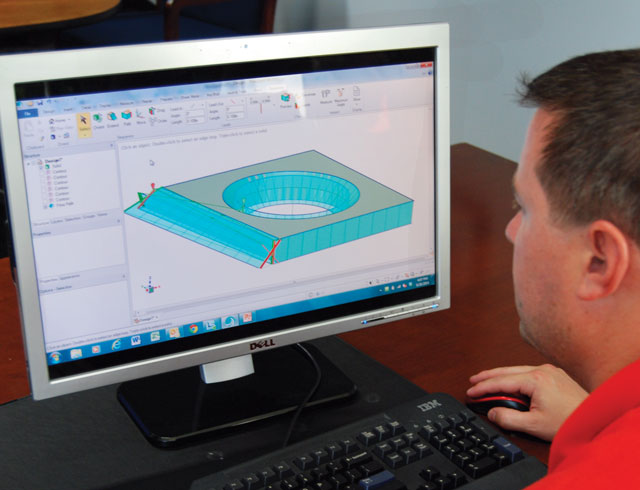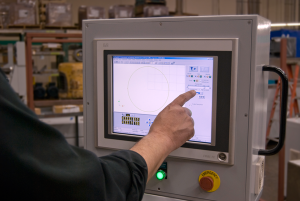A waterjet is a beam type cutter, somewhat like a plasma, oxy acetylene, CO2 laser, or fiber laser. Programming a waterjet, and operating one for that matter, is actually simple. In fact, a waterjet is usually considered to be easier to program and operate than most other machine tools. I say this because a waterjet typically does not require a change in parameters when going from one material to another. The tool is non-contact, pierces material easily to start a cut, and cuts without heat so materials don’t change or warp from the cutting process. If you are newer to this blog, a previous article on what makes up a waterjet might be a good precursor to reading this post.
With waterjet, the same cutting parameters are used when cutting aluminum, glass, or titanium; only cut speed is changed. Most of my customers run with the same process parameter set on everything they cut; the same water orifice size, the same abrasive mesh size, the same abrasive flow rate, the same water pressure, and the same standoff distance between nozzle tip is used for almost all materials. It is actually quite amazing. Kind of like the way you use one chain saw to cut down any species of tree, and you usually run the chainsaw at full speed when cutting.
But the waterjet beam is not rigid when it is cutting the material – it is flexible. The way the jet behaves in material influences how you program a part. On advanced waterjet machines with intelligent control systems, the program will automatically slow down on the corners and speed up on the straights to avoid the corner wash out. Even more advanced systems, which happen to be our most popular, actually tilt the head to compensate for stream lag and taper, thereby producing parts much faster and tighter tolerance.
So, for our example of programming a part let’s assume that we have an intelligent controller that is capable of handling all of the corner slow-downs. We need to get a pattern into the machine tool controller. To do this, we draw the pattern in a CAD (computer aided design) software package. But we can’t just cut the part quite yet; the machine doesn’t know where to start and stop, or how fast to go. To add all the information the machine tool needs to know, we put our CAD drawing through a CAM program (computer aided manufacturing).
This software allows the programmer to sequence the part in a program language that the machine tool can execute. If our pattern is a square with a hole cut out of the middle, then it might tell the machine tool that we want to start first on the inside hole, have the jet offset to the right by a dimension equal to the radius of the jet (approximately 0.003 inch (0.075 mm) for pure waterjet, and 0.020” (0.5 mm) for abrasive waterjet), travel clockwise, cut the inside hole first, then turn off and traverse to the outside perimeter, cut the outside in a counterclockwise direction, and stop. The cut speed is set automatically at the machine depending on the pump operating pressure, material type and thickness.
The programmer’s job is complete, now the operator takes over. The operator opens the program file in the machine tool controller. The operator clamps the material in place on the work surface of the catcher tank, jogs the cutting head to the position over the material where the waterjet is to begin the cut, turns on the pump, and presses cycle start. This action initiates the program. The water and abrasive turn on and pop through the material, the jet begins to move, cuts the inside circle segments, moves away slightly on what is called a ‘lead out,’ and then the abrasive shuts off, the machine waits a second, the water turns of (this second where the water is on and the abrasive is off gives time to remove all abrasive from the cutting head in preparation of the next on cycle), the jet makes a rapid traverse move to the start point of the outer square, cuts that portion in similar fashion, and the program ends (often with an automatic shut off of the pump and a jog move to get the machine head out of the way for the operator).
If you are cutting soft material with a pure waterjet on a waterjet shapecutting machine tool the sequence is very similar except without the abrasive control portion.
Hopefully this general overview gives you an idea of how programming works. Other machine tools will have similar steps, but few are as simple as a waterjet. Let me know what you think in the comments, we can dig into the topic of programming quite a bit more.
Thanks for reading.
chip



Your post was well written and did give me a really good idea of how water jet cutting works. I think it is awesome that you don’t have to change parameters when switching to new materials. I can only imagine how that speeds up manufacturing. My only question is whether the water jet can cut all the way through a piece of metal or glass in one pass?
LikeLike
Hi James, thanks for the comment. Waterjet (for soft materials that can be cut with a knife) and abrasive waterjet (for any hard material) is a single pass cutter. There are virtually no applications where the machine takes more than one pass. To cut something thick, cut speed is slower. To cut something thin, cut speed is faster. Some users will etch numbers or words in a part with their machine, but as for cutting – it is done in one pass.
chip
LikeLike
Thanks for the post.Visit us for best Waterjet cutting
Water jet Cutting Services
LikeLike